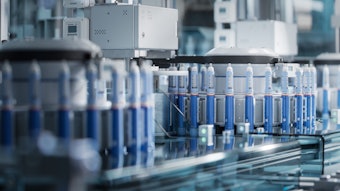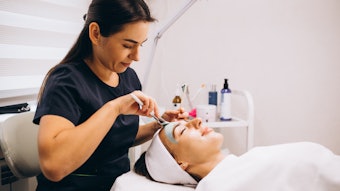
Although women are the primary demographic for the skin care and medical aesthetic industries, there is a significant market for men as well. More men are turning to aesthetic procedures and skin care products for self-care and anti-aging benefits. Entire lines are now dedicated to men’s products, with claims they are specifically formulated for men’s skin. The market for men’s beauty continues to grow with no signs of slowing down. Here are four of the latest aesthetic treatments for men rising to the top of the trends.
Growing Market Trends in Men's Aesthetics
Per Statista, the global male grooming market will be worth $115 billion by 2028, up from nearly $80 billion in 2022.1
Qsight Guidepoint reports that in 2023, men spent an average of $1,678 on non-surgical aesthetics services and products, compared to $1,357 for women. On a per-visit basis, men spent an average of $732, while women spent $524.
Annual per-patient spending has grown faster among men than women. Since 2017, per-patient spending among men has increased by an average of 7% per year, while per-patient spending among women has grown by an average of 3% per year.
Spending on professional grade skin care has grown among men, per Qsight. On average, men spent $142 per visit on professional grade skincare products, up from $133 in 2022 and $120 in 2021. Women spent around $150 per visit on professional grade skin care products in 2023.2
The men’s skin care products market is projected to reach $28.345 billion by 2029, growing at a double-digit CAGR through the forecast period, according to a market study from Future Market Insights.3
Ahdarsh Vallabhaneni, M.D., presented an abstract at the 2024 Conference of the American Society for Laser Medicine and Surgery (ASLMS) that evaluated trends in men’s cosmetic treatments.
The study, “Analyzing Cosmetic Trends in Men: Insights from a Single-Center Data Study,”5 explored the trends in cosmetic procedures sought by patients over a ten-year period at a single-center dermatology clinic.
In both genders, there was a yearly increase in cosmetic visits from 2015 to 2023, outside of the pandemic-driven year of 2020. The number of male patients seeking cosmetic treatments has increased by approximately 1.5 times since 2021, per the study.
Dr. Vallabhaneni concluded that “given the differences in cutaneous biology and anatomy between genders, aesthetic treatments for men necessitate nuanced approaches and specific modifications compared to those routinely performed on women.”
1. Semaglutide for Weight Loss: The Ozempic Phenomenon
In the 2024 year-to-date, weight loss treatments have accounted for 17% of non-surgical aesthetics spending by men, up from 13% in 2023 and 5% in 2022. This increase has been largely driven by the ongoing surge in semaglutide prescriptions like Ozempic and Wegovy, according to Qsight.
Ozempic is the most searched weight loss drug, outpacing Wegovy, its closest competitor, by 300%. The total prescriptions for Ozempic in 2022 reached 2.2M, marking a staggering 857% growth since 2019. Approximately one-quarter of all Ozempic prescriptions were issued for individuals not diagnosed with diabetes even though the drug is not yet officially approved for weight loss.4
Once it hit the mainstream, Ozempic (and other semaglutide drugs) accelerated into new possibilities, with clinical trials exploring its potential use for additional health ailments, celebrities and influencers sharing their Ozempic journey and the fitness industry beginning to embrace its weight loss support.
2. Hair Restoration
Male patients spent an average of $5,335 per visit on hair transplant and restoration treatments in 2023, marking a 14% increase over their average per-visit spend in 2022. Hair transplantation and restoration treatments were the leading category of aesthetics spending among men in 2023, accounting for 30% of total men’s aesthetics spend (excludes general surgical procedures). This was followed by neurotoxin injections (17%) and energy-based device procedures (16%), per Qsight.
A December 2023 study6 explored the potential of relocating beard and body hair to bald areas of the scalp through a body hair transplantation procedure. The study was conducted across the United States, Colombia, Mexico and India, analyzing 82 patients with an average age of 48.9 years old.
The UGraft Zeus, a novel skin-responsive device, was used to facilitate the body hair transplantation procedures and address complexities encountered by previous hair restoration techniques. The device distinguishes itself with proprietary design features, including a unique self-navigating capability adept at navigating diverse skin textures, thicknesses and varying levels of hair curliness during Follicular Unit Extraction. This capability minimizes graft damage and fosters improved wound healing, according to the study.
The study reports that graft attrition rates below 7% were consistently achieved in the body hair transplantation procedures, marking a significant advancement over prior technologies that reported damage rates as high as 20% (beard) and 30% (body). More than 79% of patients reported high satisfaction six months post-procedure.
Microneedling can help to stimulate the scalp and hair follicles directly, providing a targeted approach to hair restoration. Combining microneedling with PRP, oral or topical solutions can further enhance the results and promote hair growth. Rolling a microneedling handpiece outfitted with tiny needles across patchy areas on the scalp creates microscopic wounds. The punctures in the upper dermis and into the dermal layer stimulate growth factors and tissue recovery, resulting in the body rebuilding the scalp and hair follicles.7
3. Penile Enhancement
Penile enhancements, particularly newer and safer penile enhancement procedure innovations such a those that involve injecting hyaluronic acid dermal fillers into the penile shaft and glans to increase the penis’ width and add a small amount of length, are increasingly popular with men who are looking for a change to their sex life. The treatment requires multiple sessions and can cost around $15,000. Other than some bruising and swelling, the recovery process is predictable and fast, allowing sexual activity to resume within one week of the procedure.
A 2022 study in the Aesthetic Surgery Journal analyzed online questionnaires filled out by men seeking to undergo a penile girth augmentation. The survey aimed to assess patients' motivations, including penile size self-discrepancy, psychological distress, self-esteem, body image–related quality of life, body dysmorphic disorder (BDD) and cosmetic procedure screening scale-penile-focused dysmorphic disorder.8
In this study, self-confidence was the most reported motivation for men seeking penile girth augmentation. Other motivations included a desire to improve self-confidence, change penile size/appearance, sexual function/pleasure, feelings of insecurity and medical issues. The men perceived their actual penis size as significantly smaller than the ideal size, the size they believed their penis should be and their expected size post-augmentation. The study suggests that men undergoing these procedures may be underestimating their own penile sizes and overestimating those of other men, a phenomenon supported by previous research, with attitudes that are influenced by pornography and societal stereotypes.
Another 2022 study in the Aesthetic Surgery Journal investigated men’s experiences with nonsurgical medical penile girth augmentation and assessed the impacts these procedures had on penis size and associated psychological well-being.9
In this study, around half of the men reported increased self-confidence and increased sexual pleasure after their procedure. Despite an average girth increase of 3.29 cm, the men still perceived that their penile girth and length were less than what they should be or less than the ideal size after their augmentation procedure, per the study. However, this perceived discrepancy was significantly smaller than before their procedures.
Although the results were mostly positive, there were no reported changes in psychological distress, self-esteem or body image-related quality of life, and a sizable percentage reported fewer positive impacts, particularly concerns with the aesthetic outcomes.
4. Limb Lengthening
Limb lengthening surgery is growing in popularity despite being expensive and potentially painful with months of intense physical therapy. The long and insurance-less process is seemingly worth it for men who see adding a few extra inches to their frame as a potentially life-changing procedure—and data seems to suggest they are right.
With limb lengthening surgery, someone can be up to 3 inches taller, and with two surgeries, they could be up to 6 inches taller. The four-hour operation costs $75,000 to $280,000 and is not generally covered by insurance. At least four months of daily physical therapy is required, and patients typically use a walker and then a cane to regain mobility.
An April 2006 study at the University of Chicago suggested women prefer tall men for romantic ventures. Men in the 6’3 - 6’4 range reportedly received 65% more first-contact messages than men in the 5’7 - 5’8 range. The study concluded that women have a strong aversion to men who are shorter than themselves, and regardless of their own height, women prefer to meet tall men.10
There also appears to be a significant height premium for men in their careers. The same University of Chicago report found that one-inch increases in height are related to a 1.4% increase in earnings. A man who was 5 feet 6 inches tall needed an additional $175,000 to be as desirable as a man who was approximately 6 feet tall and earned $62,500 per year.
A study cited by WebMD in 2023 found that height may be an advantage when it comes to avoiding dementia. The study of more than 500 people showed that men who are about 5 feet 11 inches or taller are almost 60% less likely to have Alzheimer’s disease than those who are about 5 feet 7 inches or shorter.11
In an ever-progressing society, men are continuing to invest in their appearance, from buying premium skin care to aesthetic-based cosmetic procedures. There is a clear growing demand for anti-aging products and skin care formulated for men, and new trends evolving in men's cosmetic surgery. Having a strong perception of the latest treatment trends will help your practice take advantage of this growing patient demographic.
References:
- Statista - Size of the global men's personal care products market from 2022 to 2028
- Qsight Guidepoint
- Future Market Insights - Men’s Skincare Products Market Outlook (2023 to 2033)
- Track Drugs - Ozempic Statistics and Trends in 2024
- Vallabhaneni, Ahdarsh, “Analyzing Cosmetic Trends in Men: Insights from A Single-Center Data Study”
- "Beard and Body Hair Transplantation by Follicular Unit Excision Using a Skin-Responsive Device," Dermatologic Surgery Journal
- Tabin, Elise, “Everything You Need to Know About Scalp Microneedling, The Latest Hair-Growth Trend,” New Beauty
- Gemma Sharp, Anne Nileshni Fernando, Michael Kyron, Jayson Oates, Peter McEvoy, Motivations and Psychological Characteristics of Men Seeking Penile Girth Augmentation, Aesthetic Surgery Journal, Volume 42, Issue 11, November 2022, Pages 1305–1315
- Gemma Sharp, Anne Nileshni Fernando, Jayson Oates, Peter McEvoy, Men’s Experiences and Psychological Outcomes of Nonsurgical Medical Penile Girth Augmentation: A Preliminary Prospective Study, Aesthetic Surgery Journal, Volume 43, Issue 2, February 2023, Pages 181–191
- Hitsch, G. J., Hortacsu, A., & Ariely, D. (2006). What makes you click? mate preferences and matching outcomes in online dating. SSRN Electronic Journal.
- Cooper, J. (n.d.). How your height affects your health. WebMD











